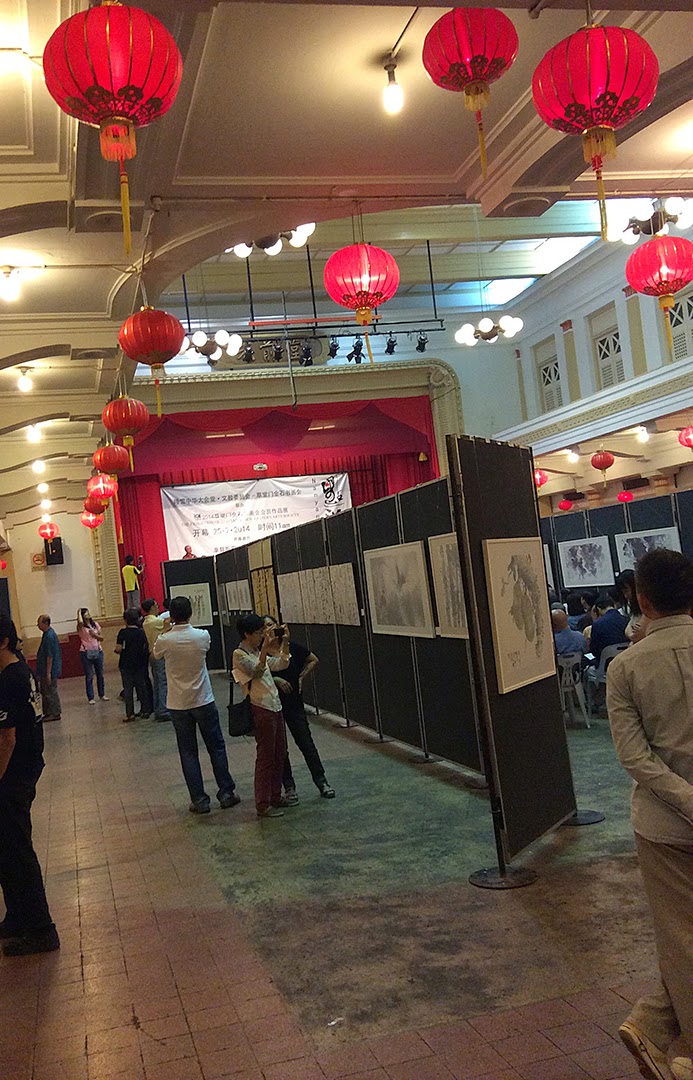Saturday, 26 July 2014
That Nanyang Touch
Sunday, 20 July 2014
Mirroring Jeganathan Ramachandram
 |
| Aandavan |
Friday, 18 July 2014
Catalonia Summer
In summer I landed in Barcelona, navigating the transport system to bring myself back to the small town of Figueres, in the province of Girona, and the friends I had made there. The delicate Catalan light effused with the memory of summery scents, fresh mottled apples, ripened strawberries and creatively misshapen brilliant red tomatoes, presented itself unashamedly to me.
I had travelled continents, traversed the intricacies of transportations to return to that very special region of Spain - Catalonia, partly French partly Spanish. Skies, under which the poet Lorca wrote and Hemmingway drank, gave up a serene Mediterranean dark phthalo blue, through which barely a titanium white cloud had drifted. I ducked sweet olive branches and once more made my way into ancient Catalonia more used to the Surrealistic eccentricities of the beloved Salvador Dalí i Domènech.
Thirteenth century Figueres, birthplace of Dali and luscious figs, sprouted green, fresh. Amidst manganese violet, madder and cooling blues the town presented antique stone facades, squares, statues and a promenade - la rambla arched with shading trees. I was awed, delighted in contrast shadow, keen streaks of sun. Majestic monuments reflected the dry heat of Orwell’s Catalonia, and its welcoming golden sun.
Figueres market brought all the colour and flavour of the comarca of Alt Empordà in one delicious arena. While housewives and tourists sampled cheeses, dates, meats and fresh fruits witnesses strawberry pits on children’s fingers stained with the colour and sweet, flavoursome juices.
Hotel Duran, gourmet haven for all that is Dali and Gala, sheltered me in its Dali room. I drank late night chocolate drinks and delicate pastries Se·ñor (Mr) Duran proffered. He talked endlessly and encouraged me to devourer a delicious midnight Crema Catalana. I stayed there, surrounded by the paraphernalia of Dali, his litho prints, newspaper cuttings, and photographs with the Durans.
In the cooling evening, gold ochre nuts (from leafy Hazel) littered cobbles near the majestic 11th century Romanesque bridge, in the antique town of Besalú. Sanguine, the colour of a poet’s blood, moss green and ebony olives succulent in their virgin oil, sat in a partially open bag as I perched on an ancient rock. I was looking at the monastery, and church, of Sant Pere (St. Peter). I had journeyed past lemon fields of Van Gogh sunflowers to that medieval town, stopping briefly to wallow in the acres of golden flowers, then sat by tumbling waters and remained dazzled by the splendid vistas that Catalonia had to offer. My driver was non other than that former family friend of the late Salvador and Gala Dali, and my new friend Se·ñor Duran.
The Catalan coast is truly brave. It is ridden rough-shod over by the sea, forming coves, caves and moulding hearts exuding bravado in their welcoming of strangers. I headed for the sea side town of Cadaqués, the beloved coastal town of Salvador Dali, Picasso, the American visionary artist Robert (Bob) Venosa and Walt Disney. I uncharacteristically sipped lemon beer (cerveza de limon) while watching sea vistas; witnessing the fuchsia sky closing toward sunset. Red sea vessels echoed the tiles of distant roofs, prominent amidst the green of plentiful olive trees.
It was in Cadaqués that I met Joan Vehí. He had been Dali’s good friend, frame maker and, eventually, the photographer whom we have to thank for so many images of Dali, his family and his life. Vehí, bald, creased with years but still smiling his magical smile, regaled me with remembrances of his contacts with Dali, the portraits, the craziness, the honesty and the loyalty of Dali. Sitting with an architect friend,Ignacio Puras Abad, in the cafe Rosa Azul, Cadaqués, I took Catalan coffee.
For a moment, I dreamt a sighing dream of home, of Constable country, of tumbling clouds rolling over the Essex/Suffolk border. But I was in Spain and comforted by the trailing vines of gorgeous grape and the sweet, pulpy blackberries of Port Lligat, rambling near Dali’s former home. In Port Lligat, I had stood in front of Dali’s painting of Gala as a Leda, approached by the swan Zeus (a replica for tourists), a Catalonia seascape in the background. Others gawped and gaped, hastily taking photographs. I watched the delight of fellow tourists.
I walked from Sant Martí d’Empúries to L’Escala, to Roses and around the uniquely charming small city and Roman citadel, of Girona. I sauntered down shaded alleyways, climbing cathedral steps, gazing at rivers from tentative bridges, and soaked up the Mediterranean atmosphere, easing into the casual lifestyle of coffees and pastries, olives and local Cava.
Back in Figueres, I went to see the gothic Church of Sant Pere, then seated opposite the Dalicatessen Cafe, in Career Sant Pere, and adjacent to the Dali Museum I looked at those still waiting in line for tickets to the Dali Museum. It is in that very Dalicatessen cafe, in a large gallery set aside for such purposes, and owned by Martí Dacosta, that exhibitions are held.
Then, almost as quickly as it had begun, my sojourn in Figueres, Catalonia and Spain, was finished. With more than a little sadness, Se·ñor Duran drove me the full length of Figueres town, past La rambla, and past the farmer’s market to the waiting train station. He bade me a teary farewell. I returned to Malaysia, my home, but had left a large part of my heart in Figueres.













